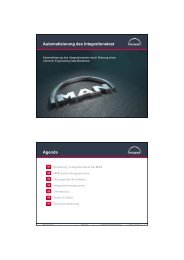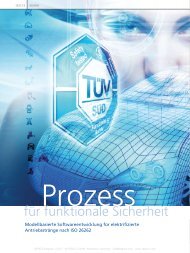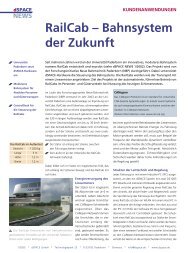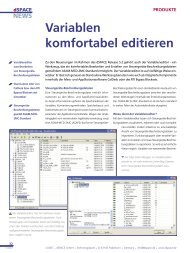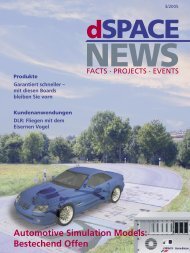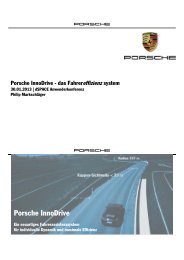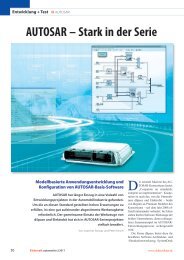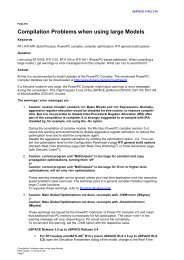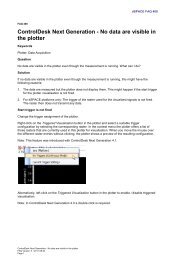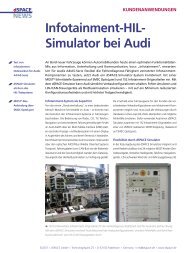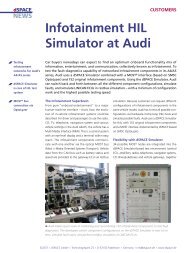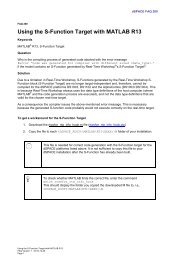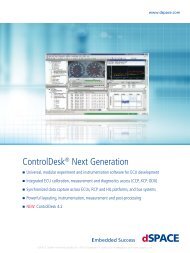magazinE - dSPACE
magazinE - dSPACE
magazinE - dSPACE
You also want an ePaper? Increase the reach of your titles
YUMPU automatically turns print PDFs into web optimized ePapers that Google loves.
“ We replaced the ECU with a <strong>dSPACE</strong> Micro<br />
AutoBox. It allowed us to control all engine<br />
tasks and easily customize the control laws.”<br />
Cesare Pianese, University of Salerno<br />
The developed control strategy is very accurate because it follows the target AFR faster and<br />
more precisely than the native ECU does.<br />
sensor location, the controller was<br />
tested on the first cylinder only, while<br />
a classical mapbased injection strategy<br />
was used for the three remaining<br />
cylinders.<br />
Results for the Direct Controller<br />
The trained IRNNM simulates the<br />
inverse AFR dynamics as accurately as<br />
the FRNNM does for the forward<br />
dynamics. Online tests on the developed<br />
RNNs were performed by<br />
integrating the FRNNM and IRNNM<br />
in the framework of a MicroAutoBox,<br />
resulting in the neural controller<br />
structure.<br />
Conclusion<br />
The virtual sensor (the FRNNM) adequately<br />
predicted the AFR dynamics<br />
with an estimation error vs. the measured<br />
trajectory lower than 2 % for<br />
most of the test transients, even<br />
when wide AFR spikes were present.<br />
This proves that the RNN dynamic<br />
behavior is satisfactorily close to the<br />
real system dynamics.<br />
The controller, which also uses the<br />
virtual sensor prediction, was implemented<br />
on the ECU and tested over<br />
an experimental transient. The comparison<br />
with the AFR trajectory<br />
resulting from the action of the reference<br />
ECU shows that the controller<br />
performs well. In particular, the<br />
integration with the virtual sensor<br />
prediction induces a higherorder<br />
response that results in a faster AFR<br />
compensation and, particularly, in<br />
the removal of the overshoot observed<br />
by the ECU. In this context the<br />
MicroAutoBox was a great help, since<br />
its high computing power always<br />
ensured sufficient headroom for the<br />
realtime execution of the complex<br />
algorithms. The results demonstrate<br />
that neural controllers have a great<br />
potential for improving engine<br />
control strategies, especially since<br />
they significantly reduce the amount<br />
of experimentation and calibration<br />
needed by other current methods.<br />
Ivan Arsie, Silvana Di Iorio, Giuseppe Noschese,<br />
Cesare Pianese, Marco Sorrentino<br />
pianese@unisa.it<br />
Department of Mechanical Engineering<br />
University of Salerno, Italy<br />
Glossary<br />
air-Fuel Ratio (aFR) – Mass ratio of air<br />
to fuel present during combustion.<br />
It is an important measurement for<br />
anti-pollution and performance tuning.<br />
Lambda (λ) is the alternative expression<br />
for the AFR. For pure octane the<br />
optimal ratio is λ = 1.00 (stoichiometric<br />
mixture of air to fuel 14,67:1).<br />
Lambda Sensor – Also known as oxygen<br />
sensor. It monitors the amount of<br />
oxygen in the exhaust, so the ECU can<br />
determine how rich or lean the fuel<br />
mixture is and make adjustments if<br />
necessary.<br />
neural network – Made of individual<br />
units named neurons. Each neuron has<br />
a weight associated with each input.<br />
A function is then generated as output.<br />
Typically the neurons are connected<br />
together with an input layer, an output<br />
layer and one or more hidden layers.<br />
Recurrent neural networks (RNN) are<br />
derived from the static networks by<br />
introducing feedback connections<br />
among the neurons. A dynamic effect<br />
is introduced into the computational<br />
system by a local memory process.<br />
Advantages of RNNs are that they can<br />
be sensitive and adapted to past inputs.<br />
Input layer Hidden layer Output layer<br />
D D<br />
Recurrent neural network (RNN).<br />
pAGe 23



